|
QUEENSLAND FOREST HISTORY
STORIES
An
alien workforce
Board
introduces a century of forestry
Environmental
system to world standard
Forest
conservation started in the 19th century
A
forestry snapshot
Visionary
changes forestry forever
Motor
vehicles make easy access to natural areas
National
parks grew from bush exploration
Queensland
celebrates 100 years of forestry
Service
celebrates 25 years
Women
of the woods
AN
ALIEN WORKFORCE
by John Schiavo
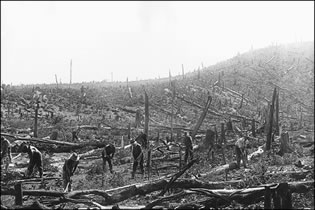
Forestry's "reservoir of labour"
Former
unemployed men work burnt scrub to plant forests during the Great
Depression
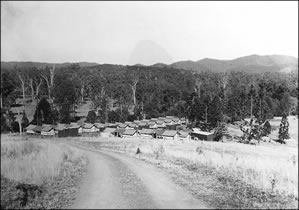
A safe haven for
displaced persons. These temporary forestry camps in rural Queensland were
spartan, but were a "million miles" from war-ravished Europe during and
after the Second World War
One of the most interesting
periods in the history of Queensland Forestry occurred in the years during
and after the Second World War.
With all Australia involved
in the war effort, the construction of defence installations placed a
heavy burden on timber supplies. Forestry was regarded as an essential
industry and measures were taken to ensure that timber was made available
for the war effort.
As the male labour force shrunk, European
prisoners of war were used to harvest Queensland's timber. Prisoners of
war were sent to the Mary Valley as well as the Brigalow district around
Chinchilla.
The need for timber became even greater for
reconstruction after the war. Housing shortages placed a huge demand on
wood supplies but the workforce to cut the timber was not
available.
The solution came in the form of European refugees,
officially referred to at the time as displaced persons. The Australian
Government agreed to accept these people in July 1947.
While
millions of war refugees were resettled in the intervening period, about
one million refused to return to their homelands. The majority of these
displaced persons came from eastern Europe and remained in holding camps
in central Europe after the war.
There were, however, a number of
conditions placed on the agreement between the Australian government and
the United Nations who coordinated the Displaced Persons Mass Resettlement
Scheme.
People entering Australia had to agree to work for two
years in any employment as directed by the Commonwealth Government.
Essential industries in Queensland included the sugar industry and
forestry. After this two-year contract expired, displaced persons were
allowed to find their own employment. The scheme operated between 1947 and
1952.
During this time, between 6000 and 8000 men and women were
employed in Queensland. About 1000 were employed by the Department of
Forestry.
This workforce peaked during 1950 when more than
650 men were employed, primarily in the massive reafforestation program
undertaken by the department.
The largest concentrations of
forestry-employed displaced persons were at Imbil, Amamoor, Widgee,
Gallangowan, Yarraman, Benarkin, Blackbutt, Colinton, Chinchilla, Elgin
Vale, Atherton, and Beerburrum.
While some workers objected to the
remoteness of the work and gravitated to coastal towns and cities, others
remained employed by the Forestry Department after their contract had
expired.
BOARD INTRODUCES A CENTURY
OF FORESTRY
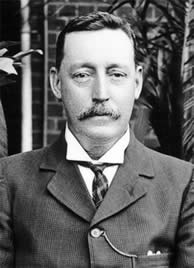
George Leonard
Board
This year commemorates 100 years
since the appointment of George Leonard Board as Queensland's first
Inspector of Forests.
When Leonard Board took up his appointment on
1 August 1900 he began an era of official forest stewardship for the
state.
He was the first of a line of forestry heads who
progressively refined forest management to a science that balanced
ecological needs with community needs for timber, recreation and multiple
uses such as grazing and bee-keeping.
When Board was appointed,
Forestry was a branch of the then Department of Public Lands.
His
staff consisted of two forest rangers, and, for the annual salary of £500,
he administered a rapidly growing industry throughout the
state.
The Maryborough Chronicle in 1900 said of Leonard Board's
appointment: "He is without a doubt one of the most experienced and
capable men in the Lands Department, and he will not only fill the
Inspectorship with credit (he will) make it a most serviceable and
important office."
From a branch in the Public Lands Department,
Forestry became variously the Department of Forestry, the Queensland
Forest Service, and a business group within the Department of Primary
Industries.
While the one-time Forestry Department had
responsibility for almost all forest-related activities in Queensland
(including national parks), forestry administration is now spread across
several departments including the Department of State Development, the
Department of Natural Resources, the Environmental Protection Agency, and
the Department of Primary Industries.
DPI Forestry is the
commercial arm of the Queensland Government's forest production
activity.
The history of the state's forest leaders shows similar
changes.
Leonard Board was an Inspector of Forests. Immediate
successors were known as Directors. Then came Conservators, and now,
Executive-Directors.
Leonard Board served from 1900 to
1905.
Then came P. MacMahon (1905-1910), N.W. Jolly (1911-1918),
E.H.F. Swain (1918-1932), V.A. Grenning (1932-1964), A.R. Trist
(1964-1970), C. Haley (1970-1974), W. Bryan (1974-1981), J.A.J. Smart
(1981-1985), J.J. Kelly (1985-1988), T. Ryan (1988-1993), N. Clough
(1993-1995), T.N. Johnston (1995-1996), G.J. Bacon (1996-1998), and R.G.
Beck (1998-).
ENVIRONMENTAL SYSTEM TO
WORLD STANDARD
Forestry in Queensland over the
last 100 years has been driven by a commitment to environmental best
practice.
The reason for this is simple, and was espoused by
forestry leaders of early last century: if your livelihood depends on the
forests, you look after them.
Last year was a milestone for DPI
Forestry, which, after an exhaustive independent certification process,
had its Environmental Management System certified to the International
Standard ISO 14001.
DPI Forestry's environment management is first
and foremost about sustainable forest management and
production.
Flow on benefits include assisting industry to
gain competitive market advantages and improved risk management.
FOREST
CONSERVATION STARTED IN THE 19TH CENTURY
by Peter
Holzworth
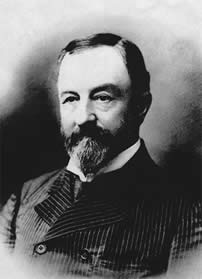
Archibald
McDowall
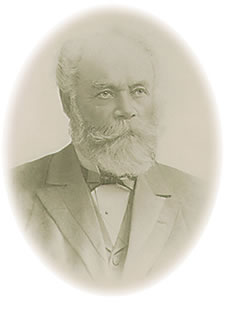
Richard M
Hyne
Many believe forest
conservation began in the 1970s with the burgeoning conservation movement,
but there were several men of conviction and influence in Queensland who
fought and won the battle for forest conservancy in the 19th
century.
Among them were Archibald McDowall, later to become the
state's Surveyor-General, and Richard Hyne, businessman and
politician.
The early history of the colony followed the usual
processes of new settlement - survival and establishment, expansion and
utilisation of natural resources and, finally, a growing awareness of the
need for protection and better management of those
resources.
During the early decades of settlement, the forests were
essential in supplying the new colony with timber for housing, mining,
fencing and the building of railways. The abundance of pine, red cedar and
other hardwood seemed limitless. But much was wasted due to
inaccessibility, transport problems, natural decay and the use of only the
best logs from the fallen trees.
Concerns about the indiscriminate
cutting of forests began to emerge in the 1860s and some timber
regulations were introduced by the government, but these only provided low
level controls on timber-getters. In any case, the government was
committed to settlement and introduced Acts of Parliament in 1860 and 1868
allowing the private purchase of land for agriculture and pastoralism.
This led to a greater reduction of the forests.
Among the
first voices to raise concern were those of the Acclimatisation Society of
Queensland. In 1870, the society wrote to the Colonial Secretary about the
over-cutting of forests, especially the effect such actions might have on
climate, but the government was unmoved.
In 1874, the
Secretary of State for the Colonies sent a questionnaire on forestry
matters to Walter Hill, head of the Brisbane Botanic Gardens. Hill
responded by pointing out the wastage associated with poor logging
practices and widespread ring-barking.
The case against these
practices was then taken up in 1875 by John Douglas, the parliamentary
member for the timber town of Maryborough who called for a select
committee to consider forest preservation, growth promotion and
conservation of forests for utilitarian purposes.
In that
year, a Select Committee on Forest Conservancy deliberated on a number of
these issues. It accepted evidence from many sources, including two
Maryborough men, William Pettigrew and Robert Hart, both of
whom had sawmilling interests. The committee made seven recommendations,
but the government took little notice of most of them.
Argument and
debate on forestry matters continued throughout the 1870s, but the timber
industry had little political clout compared with that of the pastoral
lobbyists.
Enter Archibald McDowall. McDowall spent his early
professional years (the 1860s) surveying in the Maranoa, Warrego and
Kennedy districts, but it was during his time in the Maryborough-Wide Bay
area that he made his presence felt in the debate over the best use of the
state's forests.
And he did it in practical ways. While others had
advocated logging restrictions, the introduction of forestry legislation
and the increased reservation of productive forestry lands, McDowall -
while in agreement with these sentiments - went a step further in
promoting trial plantings, silvicultural practices in forests and many
other forestry innovations.
McDowall carried out plantation
experiments on Fraser Island from 1875 to 1885. His men cleared
undergrowth around kauri pine seedlings and saplings to encourage greater
growth. They also extended logging clearings in the scrub, planted them
with kauri seedlings at set spacings and cleared narrow laneways through
the scrub and planted them with seedlings as well.
In
addition to the experimental plantings, he prohibited licences to cut pine
on the island in order to retain mature seed trees for future generations.
He also introduced tree-marking and sale of logs at stump, both modern
forestry practices. All this by 1889!
If Archibald McDowall saw
forest conservancy largely from a forest guardianship and arboricultural
perspective, Richard Matthews Hyne saw it as a necessary bulwark against
declining resource availability for the timber industry in
Queensland.
Hyne, from Maryborough, was deeply involved in local
politics, his region's burgeoning timber industry and forest conservancy
generally. He was not a government officer like McDowall but a successful
businessman engaged in timber-getting. He also was the Member for
Maryborough.
In 1889, Hyne introduced a successful motion in
parliament that the government act on forest replanting and create a
Department of Forestry. Although Hyne's motion was carried, no action
ensued immediately. This was not the first mention of a forest overseeing
body, as a select committee had recommended the call for a Forest
Conservancy Board 14 years before - in 1875.
In 1890, the
Queensland Government called for reports on forestry
matters.
Commissioners who made recommendations on these reports
included P. McLean, Under-Secretary for Agriculture; P. MacMahon, Curator
of the Botanic Gardens; A. McDowall, Inspector of Surveys and former
District Surveyor at Maryborough; and L. G. Board, Land Commissioner at
Gympie and Maryborough.
The commissioners recommended a plan for
forest management, emphasising three aspects:
* Conservancy -
reservation and management of existing forests
* Regeneration -
replanting and enriching production forests, and
* Extension -
extending forests into treeless areas
A Forestry Branch was created
in 1900 within the Department of Public Lands and Inspector of Forests
Leonard Board was appointed.
From a forestry viewpoint this was a
fitting conclusion to the 19th century and to the beginning of
government-approved forest conservancy.
A
FORESTRY SNAPSHOT
![Forest Showroom, George Street, Brisbane 1939]()
The Queensland
Government Forest Showroom in George Street, Brisbane, in 1939
Although
most public relations of this type is now done by industry, DPI Forestry
continues to promote timber as "the most environmentally-friendly building
product"
The forest industry is one of the
top 10 contributors to Queensland's economy and ranks as the state's
seventh largest manufacturing sector.
Industry segments
include forest growing, log sawmilling, re-sawn and dressed timber
processing, preservative treatment of timber, joinery and furniture
manufacturing, paper and paperboard production, and reconstituted board
manufacturing.
The industry is one of the main sources of
employment in many regional centres and consists of around 400 sawmills
and associated processing facilities that provide employment for more than
17,000 people. In economic terms, for every dollar spent on the raw timber
resource, a further $11.30 is injected into Queensland's
economy.
For every 10 jobs created directly by the industry, a
further 8.5 jobs are created in the wider community. In direct terms, the
annual value of the industry is estimated at $1.7 billion, however, when
flow-on impacts are considered, this value rises to $3.3
billion.
(Source: Centre for Agricultural Economics, 1998.)
VISIONARY CHANGES FORESTRY
FOREVER
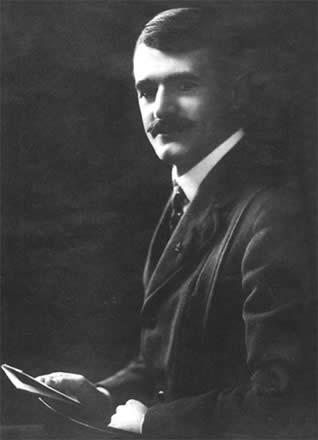
Forestry's
visionary: Edward Harold Fulcher Swain
The turning point for forestry in
Australia has often been seen as one man, a rumbustious larger-than-life
forest visionary, Edward Harold Fulcher Swain.
A New South Welshman
by birth, Swain was made Director of Forests in Queensland in 1918 and
served in that position until his dismissal in 1932.
At the time of
Leonard Board's appointment as Queensland first Inspector of Forests in
1900, Swain already had a year under his belt with the Forestry Branch NSW
Lands Department.
He spent 16 years in NSW before heading to the
United States on a two-year self-funded trip to study American
forestry.
Swain returned to take up the position of Forest
Inspector at Gympie in 1916 and became the first senior forester to
seriously question the use of European forest principles in
Australia.
Appointed Queensland Director of Forests in 1918, Swain
began his 14-year crusade to revolutionise as much of forestry as he
could.
He dictated the curriculum for the study of forestry
in Queensland, writing silvicultural manuals based on Australia's climate
rather than that of Europe's.
He set up Queensland's first forest
nurseries.
He established some of Queensland's first plantations,
including the lofty giants now surrounding the Glasshouse
Mountains.
He saw forestry as a business to be managed on business
principles.
He garnered enough support to set up the Queensland
Forest Service as a department in its own right and then moved towards
possibly his most memorable achievement - preventing the erasure of the
magnificent hoop pine forests in the Mary and Brisbane valleys.
The
pro-development Lands Department of the day was determined to clear these
forests for the growing dairy industry, but Swain locked horned with the
department's officialdom and won.
Swain was a brilliant thinker who
did remarkable things for the conservation and management of forests in
Queensland, but he worked with little fear or favour towards his political
masters.
This attitude saw him at loggerheads with any number of
elected and non-elected officials, and eventually proved his
undoing.
When the State Government of the early 1930s wanted to
open the hardwood forests of north Queensland for settlement, Swain played
the role of conservationist and vehemently opposed the plan.
He
claimed a Royal Commission for the Development of North Queensland was
"rigged", and wrote a dissenting 200-page Royal Commission report
himself.
Although his views were later endorsed by the
Auditor-General and finally adopted by the government, Swain's political
masters thought he had gone too far, and dismissed him, without
compensation, four years before his contract was to expire.
Swain
left Queensland to become NSW Commission of Forests for 13 years, and
completed his career as a United Nations forestry consultant in Ethiopia
until 1955.
E.H.F. Swain spent his retirement years in Queensland,
the state he loved best, and died in 1970.
MOTOR VEHICLES
MAKE EASY ACCESS TO NATURAL AREAS
Few things have increased
recreational visits to Queensland's forests over the past 100 years as
much as the development of the motor car.
And, according to the
Department of Natural Resources, more people camp in natural areas each
year than attend the home games of the Bronco's, Bullets, Brisbane Lions
and Queensland Reds combined.
A recent DNR study confirms
Queenslanders' attraction to natural landscapes, finding that 25 per cent
of the south-east Queensland population over 15 years camp at least once a
year.
The study also shows that 51 per cent of the south-east
Queensland population pleasure drive in state
forests.
Traditional family vehicles are the most frequent
visitors. These make up around one-third of vehicles traversing our
forests. Four wheel drives make up just one-fifth of the
visitors.
The Department of Natural Resources manages state
forests to cater for the myriad of nature-based recreational activities
that visitors enjoy
DNR Permits Officer Donna McCarther said most
people who applied for a "permit to traverse" a state forest usually
wanted somewhere to go to get away from the hustle and bustle of their
daily lives.
Permits are also required for nature-based cycling,
horse riding, motorcycle riding and camping in most state forests in
Queensland and can be obtained through regional DNR
offices.
However, access to most day use areas, walking tracks and
trails, and designated forest drives, does not require permits.
NATIONAL PARKS GREW FROM
BUSH EXPLORATION
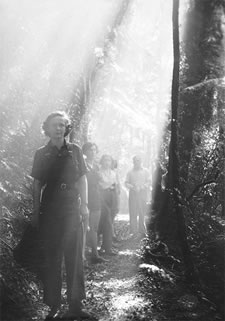
This family enjoyed
a bushwalk at Coomera Gorge, in the Lamington National Park, in
1938
As well as recognising the 100th
anniversary of the establishment of a Forestry Branch in Queensland, the
National Parks Association of Queensland (the NPAQ) is celebrating the
70th anniversary of its establishment in 1930, under inaugural president,
Mr Romeo W. Lahey.
In the late 19th and early 20th centuries, there
were a number of keen adventurers, bushwalkers and bird watchers exploring
the mountains and scenery of south-east Queensland. Roads were little more
than tracks and transport was by foot, train, milk and cattle trucks and,
occasionally, private vehicles.
Through these activities, it was
realised there was a necessity to preserve virgin areas of scenic beauty
in their natural state for the enjoyment of future
generations.
As a result, legislation to establish national
parks in Queensland was enacted in the early 1900s and the first national
park was proclaimed on 28 March 1908 at Witches Falls, Mt
Tamborine.
By 1930 the number of parks grew to 16 and, by 1940,
investigations and submissions resulted in a further 123 terrestrial and
marine national parks being proclaimed, due largely to a close association
between the Queensland Forest Service and the fledgling NPAQ.
Not
until later was the concept of preserving species and biodiversity
understood and accepted. The need to retain species of flora and fauna and
be aware of the surrounding environment is even more urgent
today.
This has required the NPAQ to exercise a greater degree of
vigilance in
monitoring both Commonwealth and state legislation to
ensure it retains and protects world heritage areas and Australia's
national identity.
QUEENSLAND CELEBRATES
100 YEARS OF FORESTRY

Executive Director, DPI
Forestry, Ron Beck
Queensland celebrates 100 years
of forestry this year. In what was one of the earliest formal recognitions
of the need for forest management, the Queensland Government established a
Forestry Branch in its Department of Public Lands in 1900.
Mr
George Leonard Board, the then Land Commissioner for the Gympie,
Maryborough, Bundaberg and Gladstone Districts, was appointed the state's
first Inspector of Forests.
Known to all as Leonard Board, he took
up his position on 1 August 1900.
In 2000 the Queensland Government
agencies now managing forests in Queensland have planned a number of
celebrations to commemorate Queensland's forest
centenary.
Community organisations have also joined the
celebrations. These events include public displays and community
activities in Brisbane and throughout Queensland.
Present-day DPI
Forestry Executive Director Ron Beck said the range and nature of state
government forestry functions had continued to evolve and develop and
today were managed by DPI Forestry, the Department of Natural Resources,
the Environmental Protection Agency, and the Department of State
Development.
"These agencies, together with the timber industry,
forest industry workers and the broader community have been key players in
the developing relationship between government, industry and the community
during the past 100 years.
"This 100th anniversary provides
Queensland with an avenue by which we can pay tribute to the early
architects of the forest and timber industry and those who have progressed
the profession down the years.
"Their vision, enthusiasm,
innovation and downright hard work created a multi-million dollar industry
which is essential to the health of the Queensland economy," Mr Beck
said.
Mr Beck said it was his privilege to head DPI Forestry
as it entered the next 100 years.
"It will be difficult to fill the
shoes of our pioneering giants, but they have shown us what can be
achieved through commitment and a sense of purpose," he said.
SERVICE CELEBRATES 25
YEARS
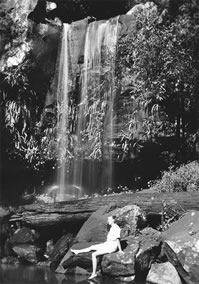
A young
bushwalker enjoys Curtis Falls in Tamborine National Park in
1937
As well as 100 years of forestry,
this year marks the 25th anniversary of the Queensland Parks and Wildlife
Service. The Service was formed on 5 June 1975 under the National
Parks and Wildlife Act.
It combined the National Parks Branch of
the then Department of Forestry and the Fauna Conservation Branch of the
Department of Primary Industries and created a single government authority
responsible for conserving native plants and animals and areas of scenic,
historic and scientific interest.
The Service's lineage,
however, can be traced to the 19th century.
In 1878 Tamrookum pastoralists
Robert Martin Collins and his
brother William visited the United States Robert and were
impressed by the world's first national park, Yellowstone National Park,
created in 1872.
As a member of Queensland Parliament (from
1896 to 1899) and Queensland President of the Australian Royal
Geographical Society, Robert Collins campaigned to
reserve scenic areas of the McPherson Ranges he could see from his
home.
His lobbying proved successful and the government accepted
the national park concept, passing the State Forests and National Parks
Act in 1906.
The early 1900s also saw local councillors Syd Curtis
and Joseph Delpratt became alarmed at the amount of clearing taking place
on Tamborine Mountain.
On 15 June 1907 the council
recommended that a part of the mountain be set apart as a reserve and on
28 March 1908 Witches Falls National Park became Queensland's first
national park.
Later the same year a halt was declared in clearing
the dense forests along the top of the Bunya Mountains when Bunya
Mountains National Park was declared.
On 31 July 1915 an area of
47,000 acres (19,000 ha) in the McPherson Ranges was reserved as Lamington
National Park, thanks to Collins' foresight and
the efforts of a young engineer Romeo Watkins Lahey, from a Canungra
sawmilling family.
Lahey convinced the Lands Minister that a large
reservation in the rugged area would have more benefits to the community
than logging and clearing and spread the national park concept more widely
when he became the founding president of the National Parks Association of
Queensland in 1930.
Over the years, the Forestry Department had a
small but very dedicated staff working on national parks. A handful of
rangers was responsible for managing and protecting parks often many miles
apart and they struggled to do their job effectively.
Fortunately,
foresters always had an eye out for the best of nature and landscape and
identified and recommended scores of areas large and small to be added to
the slowly growing Queensland national park tenure.
Today's
Queensland Parks and Wildlife Service is responsible for managing 212
national parks covering 6,623,648 ha or about 3.8 percent of Queensland.
THE
EVERGREEN YEARS - MILESTONES IN QUEENSLAND'S FOREST
HISTORY
by Peter Holzworth,
Ian Hatcher, and Kieran Lewis
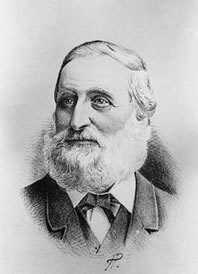
William Pettigrew,
who set up Queensland's first modern sawmill on the banks of the Brisbane
River in 1852
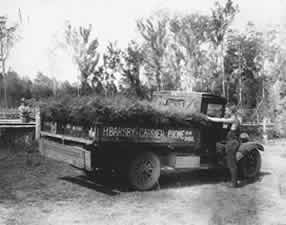
Tins of tubed hoop
pine seedlings ready for transporting to Queensland's first major native
conifer plantations
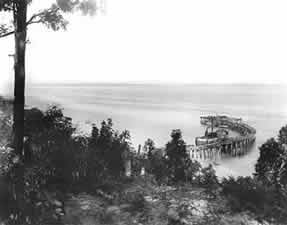
Log punting
at McKenzie's Jetty on Fraser Island in 1929. Fraser Island was the site
of early exotic pine plantations in Queensland
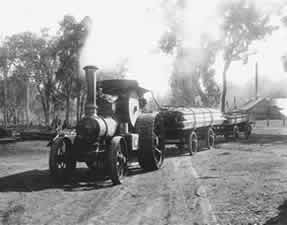
A steam tractor hauls
sawn hoop pine from a Benarkin sawmill, c. 1923
![Steam logs for veneer production]()
Steaming logs for veneer
production at Brisbane Sawmills in 1932.
There were 600 licensed
sawmills in Queensland in the 1930s. (There are about 400
today)
In 1823, Surveyor-General John
Oxley sailed into the Brisbane River and saw "timber...of great
abundance". Just 17 years later, following a time as a penal depot, free
settlers began to colonise areas to the north and west of
Brisbane.
Much timber was needed in the colony for housing,
boat-building, fencing, and other development and forests were logged for
pine, cedar and other hardwoods.
William Pettigrew contributed to
the production of sawn timber for the burgeoning colony by opening the
first sawmill in Brisbane in 1852 and his name has become synonymous with
the start of a genuine forest and timber industry in
Queensland.
The Queensland Government proclaimed its first timber
regulations in 1860 with the accompanying threat of seizure of logs if
timber-getters were found not to be complying with the regulations. The
first timber reserves were gazetted in 1870.
Archibald
McDowall became a strong advocate of forest conservancy around this time.
A district surveyor at Maryborough and later Surveyor-General of
Queensland, McDowall showed great vision on many forestry issues,
foreshadowing later forest management practices and the drive for forested
land reservation.
A Forestry Branch was created in 1900 in
the Department of Public Lands and an Inspector of Forests, George Leonard
Board, was appointed, along with two forest rangers in supporting field
roles.
At the time of Board's appointment, the area of forest
reservation in Queensland was about a million and a half acres. Within two
years, this had doubled and, by the end of 1904, the figure had risen to
well over three and a half million acres.
The extent of the forest
estate was rapidly increasing but exploitation of Queensland's forests for
timber continued.
A further positive move in the first decade of
this century was the enactment of the State Forests and National Parks Act
of 1906. Effective from 1907, Crown lands for the first time could be
reserved as state forests or national parks.
In 1908
Queensland's first national parks were declared at the Bunya Mountains and
Mt Tamborine.
In 1911, under new Director of Forests N. W.
Jolly, the need for a "determination of annual permissible cut" was
proclaimed. This was formalised in 1926 when the Forestry Branch regulated
the amount of timber that could be cut by the industry in state forests
and timber reserves.
During the tenure of Jolly, from 1911 to 1918,
forestry began to take on a professional image for the first time. The
seeds of a new "Forestry" were being sown - forest inventory surveys,
yield calculation, silvicultural research trials, timber technology and
rudimentary fire protection.
The early exploitation of the
forests had diminished the "great abundance" of Oxley's day, but forest
management changes about to be made by modern foresters and rangers were
to redress the imbalance.
Strict rules covering the logging
of hardwood forests were introduced in 1937, based on sound silvicultural
principles and with the goal of maintaining sustainable harvesting of the
hardwood needed to meet the growing demand of the construction
industry.
The plywood industry began during the First World War. By
1926, there were eight plywood plants in the state, using six million
super feet of timber, mostly hoop pine. The Sawmill Licensing Act was
passed in 1936 regulating the sawmilling industry when there were 600
sawmills registered in the state.
During the Depression of the
early 1930s, various relief programs were provided to save people from the
dole. During World War II, massive quantities of timber were cut for the
war effort and the industry was declared an essential industry.
The
beginning of Queensland's enormously successful native conifer planting
program began in the 1920s. The early plantations were of native species
such as hoop pine, which required very fertile sites also in demand for
agriculture and settlement.
Those first plantations were seeded by
the newly-named Queensland Forest Service in 1920-21 and were mostly hoop
and bunya pine. The Mary Valley, the Brisbane Valley and far north
Queensland were destined to become the principal centres for growing these
conifers.
Ten years after the native conifer plantation program
began, the Queensland Forest Service began its exotic pine program. Early
plantings of pinus species occurred at Fraser Island, Atherton and
Imbil.
Forest conservators N.W. Jolly and E.H.F. Swain played
pivotal roles in the development of these
plantations.
Swain's use of matching species around the
world, using similar climatic patterns, was very successful in identifying
slash (Pinus elliottii) and loblolly (Pinus taeda) pines as being suitable
for Queensland.
Caribbean pine (Pinus caribaea) would show
great promise in trials in the mid-1970s, becoming successful north of
Beerburrum.
From 1945, various Queensland governments actively
supported a freeholding policy that allowed private citizens to purchase
and clear large tracts of Crown land for agricultural
production.
The Forestry Department, as it had then become,
challenged many freehold applications and was successful in retaining vast
areas, some tens of thousands of hectares, for state forests.
But
it was a fundamental legislative change that occurred in 1959, the
promulgation of the Forestry Act, which has been the driving force behind
forest management in modern times.
Among other things, the Forestry
Act enshrined cardinal principles of forest management including the
permanent reservation of forests, the perpetual production of timber and
associated products, and the necessity for soil and environment
conservation and water quality protection.
For some, however,
these safeguards were not enough, with sections of the community seeing
forests as having values and uses beyond timber production. This came to
head in the battle over management of the wet tropics of north Queensland
in the 1980s and 1990s.
Struggles for stewardship of the
forest estate became militant, vociferous and widespread, leading to other
confrontations at Fraser Island and in the Conondale Ranges.
The
Regional Forest Agreement negotiations of the late 1990s, however, brought
a return of balanced decision-making based more on science and knowledge
than rhetoric and emotion. Queensland's forest stakeholder agreement,
covering native forests in south-east Queensland, is widely accepted as a
productive model for the future of the forest and timber
industry.
Other important dates for modern forestry in Queensland
included 1975, when an entire section of the Forestry Department became
the Queensland National Parks and Wildlife Service (which this year
celebrates its 25th year), and 1996, with the formation of the Department
of Natural Resources, which now has regulatory control of Queensland's
forests.
WOMEN OF THE WOODS
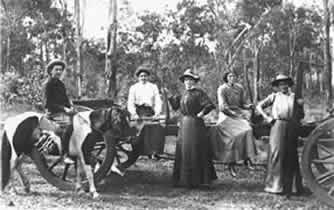
The four Lynch sisters, Mary,
Kate, Nell and Rose, toil in forests near Gympie in the late
1800s
(John Oxley Library photograph)
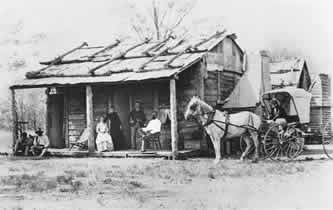
An early colonial home - forestry womenfolk provided
for their families in primitive conditions
No story about forestry in
Queensland would be complete without mention of the essential role played
by women down the years.
Settlers who forged their way through deep
timber often did so with their families in tow.
It was the
women, often just young girls, who raised and educated children, provided
for the family, worked at making a home out of a slab hut with dirt
floors, and gave essential medical aid, all with virtually no money or
home comforts, and miles from the nearest settlements.
But home
duties were not the only contribution of the women of the woods. Many
worked as hard cutting timber as the males in their families.
An
example of the indefatigable spirit of these early women is the four Lynch
sisters, Mary, Kate, Nell and Rose, who were daughters of Irish immigrant
Cornelius Lynch.
Cornelius set up a cattle property near Gympie in
the late 1800s and, being a timber-cutter, taught his daughters to clear
and fell pine and hardwood mill logs, drive bullock teams, carry out
contract fencing and cart wood for the Gympie mines.
The women
worked hard and were much in demand for they were sober, industrious and
stood no nonsense. One stranger who made an unseemly remark found himself
dragged from his horse and thoroughly rolled in a mudhole.
They
were proud, too, in the way of the Irish. A neighbour once noticed them
working hatless and bought hats for each of the girls. Next time he drove
by he saw the hats nailed to a fence post. They would take no
charity.
The girls made a good living cutting hoop pine in the
early 1900s and when timber became scarce near Gympie they moved to the
Nanango and Kingaroy districts. A bill of sale for this era shows 23,000
feet of timber sold for £6/14/5d (around $13.45).
The sisters
worked with their cross saws and axes in the Bunya Mountains and always
dressed in long black dresses when they were working.
What these
women did was not only hard physical labour demanding strength and
endurance, but it was conducted under primitive living conditions. They
were often the only women in the large logging camps and their
accommodation was a tent.
When opening up new areas, the sisters
firstly had to clear tracks so that the horse and bullock teams could get
to where the timber was cut.
The sisters were the subject of an
article in The Sunday Mail of 7 December 1975. Author Nev Hauritz quoted
two men who worked with the sisters, Charlie Birch and "Brigalow"
Masden.
Both men were around 80 years old then, but still had
vivid memories of the Lynches. They recalled "good looking women who were
a match for the male cutters".
But the four-sister felling team
disbanded when some of the girls married.
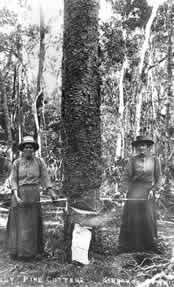
|

